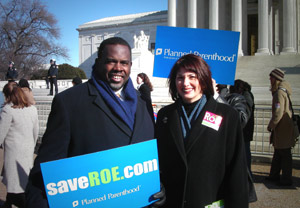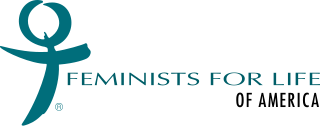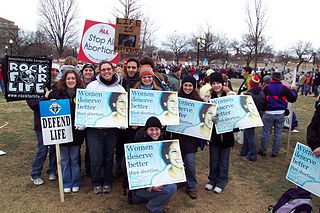Europe

In Europe, abortion law varies by country, and has been legalized through parliamentary acts in some countries, and constitutionally banned (or heavily restricted) in others. In Western Europe this has had the effect at once of both more closely regulating the use of abortion, and at the same time mediating and reducing the impact anti-abortion campaigns have had on the law. [1]
France
The first specifically anti-abortion organization in France, Laissez-les-vivre-SOS futures mères, was created in 1971 during the debate that was to lead to the Veil Law in 1975. Its main spokesman was the geneticist Jérôme Lejeune. Since 2005, the French anti-abortion movement has organized an annual March for Life. [2]
The 1920 abortion laws of France have not been entirely repealed leading to ambiguity in the nation's policies. [3] By 1975, Simone Veil, the minister for health, introduced legislation that specifically in cases of distress "tolerated" abortion up to ten weeks. [4] Abortions after this date are only cleared by the government if the pregnancy endangers the health of the woman or will result in the birth of a child with a severe and incurable disease. [4] After twelve weeks, abortion, except for "therapeutic abortion, under the terms of Article 317 of the Criminal Code, is a crime, punishable by 6 months to 10 years in prison, a fine of between 1800 and 250,000 Francs, and loss of professional license." [4]
Catholics and right-wing political groups continue to protest abortion. The Front National, an extreme right-wing anti-immigration party led by Jean-Marie Le Pen, has attempted to decrease to funding of abortions unsuccessfully even though they have around 10% of the French electorate. [3]
Ireland
There are several major anti-abortion groups in the Republic of Ireland, Pro Life Campaign, Youth Defence and Iona Institute. Despite the 1967 Abortion Act which was a significant landmark for women in the UK, it did not apply to Northern Ireland. These women either had to travel to the mainland to receive medication or face criminal charges for purchasing abortion pills illegally. [5] The Thirty-sixth Amendment of the Constitution of Ireland (2018) provided for legal abortion in Ireland, but several anti-abortion parties still campaign, including Aontú. [6] [7]
Liechtenstein
In Liechtenstein, an application to legalize abortions was rejected by a slim majority in a referendum in 2011. The opponents, which included Prince Alois, got 500 votes more and eventually settled at 52.3 percent compared with 47.7 percent. [8]
Prince Alois had announced the use of his veto in advance if necessary to prevent the introduction of abortion. [9]
Russia
Abortion is legal in Russia as an elective procedure up to the 12th week of pregnancy, and in special circumstances at later stages. [10] The abortion issue gained renewed attention in 2011 in a debate that The New York Times says "has begun to sound like the debate in the United States". [11] Parliament passed and President Dmitri Medvedev signed several restrictions on abortion into law to combat "a falling birthrate" and "plunging population". [11] The restrictions include requiring abortion providers to devote 10% of advertising costs to describing the dangers of abortion to a woman's health and make it illegal to describe abortion as a safe medical procedure. Medvedev's wife Svetlana Medvedeva has taken up the anti-abortion cause in Russia in a weeklong national campaign against abortion called "Give Me Life!" and a "Day of Family, Love and Faithfulness" by her Foundation for Social and Cultural Initiatives in conjunction with the Russian Orthodox Church. [11]
Spain
This section needs to be updated.(January 2019) |
This section needs attention from an expert in Spain. The specific problem is: Section is very outdated.(January 2019) |
In Spain, over one million demonstrators took part in a march in Madrid in October 2009 to protest plans by the government of José Luis Zapatero to legalize elective abortions and eliminate parental consent restrictions. [12]
In 2010 1,067,315 Spaniards signed a petition against the liberal abortion policy of the government. The petition was launched by the organizations "Derecho a vivir" (right to life) and "Hazteoir" (make yourself heard). [13] Hazteoir is connected to the right-wing party Vox, whose leader Santiago Abascal is a Hazteoir member. [14]
Ukraine
This section needs expansion. You can help by adding to it.(April 2020) |
Gift of Life is a medical and anti-abortion charity in Ukraine. [15]
United Kingdom
This section needs expansion. You can help by adding to it.(January 2019) |
In the United Kingdom, the most prominent anti-abortion organization is the Society for the Protection of Unborn Children. It was formed at the time of the passage of the 1967 Abortion Act which liberalized abortion law. The group campaigns against abortion, often using questionable claims, [16] and supports protests at pregnancy clinics. [17] The Anti-Abortion Act of 1967 had significant effect in Britain (excluding Northern Ireland). Rather than overturning the existing law, the act states that if at least two doctors deemed the reasons for abortion in alignment with the Act, it could legally be performed. This still meant that the punishment for women who obtained abortions contrary to the act were faced with potential life imprisonment. Doctors too could be prosecuted if they were found administering abortions without reasonable cause. [5] To this day, there are many clinics in the UK that anti-abortion activists routinely stand outside; their goal being to discourage the women entering from having their abortions. This is through two processes known as "prayer vigils" which are sometimes whispered quietly and other times said aloud to actively dissuade, and "pavement counseling" where activists approach entering women to persuade them to continue with their pregnancies. This is a practice held in low regard by women who seek abortions and the organisations providing the service as it has been known to cause anxiety and distress. [5]







